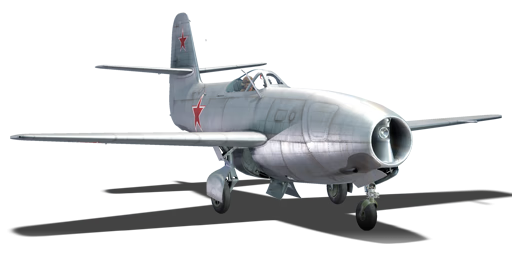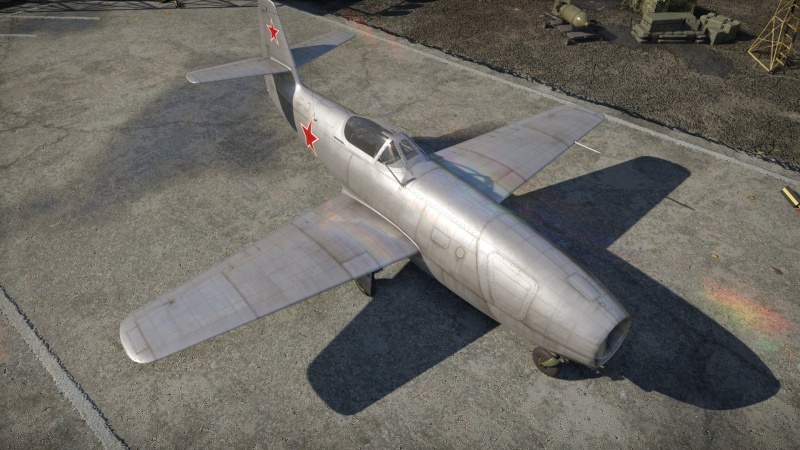Difference between revisions of "Yak-23"
KennethsTaxi (talk | contribs) (→History) (Tag: Visual edit) |
Inceptor57 (talk | contribs) m (→History: Edits) |
||
| Line 154: | Line 154: | ||
== History == | == History == | ||
| − | During early 1947, the Soviet Union wanted a single-seat jet aircraft equipped with an engine produced by Rolls-Royce. The job was given to Soviet aircraft manufacturer Yakovlev and in July 1947 the aircraft was unveiled and | + | <!--''Describe the history of the creation and combat usage of the aircraft in more detail than in the introduction. If the historical reference turns out to be too long, take it to a separate article, taking a link to the article about the vehicle and adding a block "/History" (example: <nowiki>https://wiki.warthunder.com/(Vehicle-name)/History</nowiki>) and add a link to it here using the <code>main</code> template. Be sure to reference text and sources by using <code><nowiki><ref></ref></nowiki></code>, as well as adding them at the end of the article with <code><nowiki><references /></nowiki></code>. This section may also include the vehicle's dev blog entry (if applicable) and the in-game encyclopedia description (under <code><nowiki>=== In-game description ===</nowiki></code>, also if applicable).''--> |
| + | |||
| + | During early 1947, the Soviet Union wanted a single-seat jet aircraft equipped with an engine produced by Rolls-Royce. The job was given to Soviet aircraft manufacturer Yakovlev and in July 1947, the aircraft was unveiled and flown for the first time. Just as the [[Yak-15]] and the [[Yak-17]], the main fuselage was based on that of the [[Yak-3]], and the Yak-jets along with the [[J21RA|SAAB J21R]] were the only aircraft to be successfully converted to jet fighters from piston-powered props. In 1949, the Yak-23 entered service but was not produced in large scale due to it being inferior of the [[MiG-15 (Family)|MiG-15]] that had just been mass produced and entered into service. Between 10,000-15,000 MiG-15s of different variants were built, but only around 300 Yak-23s. A few Eastern European countries bought the rights to build their own Yak-23s and some imported them directly from the Soviet Union, but many of them later opted for the MiG-15 due to it simply being better and more effective. The Yak-23 was never used in combat since the MiG-15 entered service as the Korean War broke out. The Soviet Union operated the Yak-23 between 1949 and 1951, when it was retired, and the country that used the aircraft the longest was Romania, who operated their 62 Yak-23s until 1960. | ||
== Media == | == Media == | ||
Revision as of 03:37, 21 September 2023
Contents
Description
The Yak-23 is a rank V Soviet jet fighter with a battle rating of 8.7 (AB/RB) and 7.7 (SB). It was introduced in Update 1.75 "La Résistance".
The Yak-23 is a single-engined jet fighter initially designed to intercept high altitude, long range bombers such as the B-29.
General info
Flight performance
| Characteristics | Max Speed (km/h at 0 m - sea level) |
Max altitude (metres) |
Turn time (seconds) |
Rate of climb (metres/second) |
Take-off run (metres) | |||
|---|---|---|---|---|---|---|---|---|
| AB | RB | AB | RB | AB | RB | |||
| Stock | 915 | 904 | 14500 | 19.2 | 19.9 | 37.7 | 36.5 | 650 |
| Upgraded | 939 | 929 | 18.8 | 19.0 | 52.8 | 45.0 | ||
Details
| Features | |||||
|---|---|---|---|---|---|
| Combat flaps | Take-off flaps | Landing flaps | Air brakes | Arrestor gear | Drogue chute |
| X | X | ✓ | X | X | X |
| Limits | ||||||
|---|---|---|---|---|---|---|
| Wings (km/h) | Gear (km/h) | Flaps (km/h) | Max Static G | |||
| Combat | Take-off | Landing | + | - | ||
| 1,000 | 350 | N/A | N/A | 320 | ~11 | ~8 |
| Optimal velocities (km/h) | |||
|---|---|---|---|
| Ailerons | Rudder | Elevators | Radiator |
| < 450 | < 420 | < 500 | N/A |
Engine performance
| Engine | Aircraft mass | ||||||
|---|---|---|---|---|---|---|---|
| Engine name | Number | Basic mass | Wing loading (full fuel) | ||||
| Klimov RD-500 | 1 | 2,213 kg | 215 kg/m2 | ||||
| Engine characteristics | Mass with fuel (no weapons load) | Max Gross Weight | |||||
| Weight (each) | Type | 10m fuel | 20m fuel | 30m fuel | 33m fuel | ||
| 570 kg | Centrifugal-flow turbojet | 2,431 kg | 2,643 kg | 2,857 kg | 2,941 kg | 2,974 kg | |
| Maximum engine thrust @ 0 m (RB/SB) | Thrust to weight ratio @ 0 m (112%) | ||||||
| Condition | 100% | 112% | 10m fuel | 20m fuel | 30m fuel | 33m fuel | MGW |
| Stationary | 1,367 kgf | 1,519 kgf | 0.62 | 0.57 | 0.53 | 0.52 | 0.51 |
| Optimal | 1,367 kgf (0 km/h) |
1,519 kgf (0 km/h) |
0.62 | 0.57 | 0.53 | 0.52 | 0.51 |
Survivability and armour
- 57 mm Bulletproof glass in cockpit front.
- 8 mm Steel plate behind the pilot.
Modifications and economy
Armaments
Offensive armament
The Yak-23 is armed with:
- 2 x 23 mm NR-23 cannons, nose-mounted (90 rpg = 180 total)
Usage in battles
The Yak-23 has an extremely light airframe and relatively powerful jet which gives it an enormous thrust-to-weight ratio, making it one of the best accelerating (and climbing) jets in War Thunder. The Yak-23 is not only a good bomber hunter but also an excellent fighter. Almost no jet can accelerate better than the Yak-23 below 800 km/h and no jet in the Yak-23's BR bracket can compete with its climb rate unless it has a massive energy advantage. This gives the Yak-23 a huge advantage over the vast majority of opponents it meets. The Yak-23 cannot carry any ordnance and is thus purely subjugated to fighter duties and should be used accordingly.
- Combat tactics
Always take minimum fuel (9 min) as fuel forms a significant part of the Yak-23's mass. An important fuel load will severely dampen the Yak-23's performance. Ammo is limited enough as it is so extra fuel should not be necessary anyway.
The Yak-23 should fight in the vertical and utilize its excellent manoeuvrability to take careful shots and stay out of the line of fire of enemy guns. Energy-conserving chandelles and stalls are by far the most effective tactics to utilize as they best use the Yak-23's insane acceleration and climb rate while depleting your enemy's energy.
The G.91 is by far the greatest threat to the Yak-23, as it is a small target, faster, and has high-velocity quick-firing Browning M3 machine guns that will make quick work of the Yak-23. That, combined with its excellent roll rate makes it exceedingly difficult to hit with the low-velocity 23 mm cannons mounted on the Yak-23.
Pros and cons
Pros:
- Acceleration below 800 km/h and climb rate unrivalled by anything but rocket-powered aircraft
- Excellent manoeuvrability
Cons:
- Plane wobbles badly while manoeuvring beyond 700 km/h
- 23 mm guns with low muzzle velocity and low fire rate tend to spark
- Small ammunition pool
- No additional armament or secondary weapons
History
During early 1947, the Soviet Union wanted a single-seat jet aircraft equipped with an engine produced by Rolls-Royce. The job was given to Soviet aircraft manufacturer Yakovlev and in July 1947, the aircraft was unveiled and flown for the first time. Just as the Yak-15 and the Yak-17, the main fuselage was based on that of the Yak-3, and the Yak-jets along with the SAAB J21R were the only aircraft to be successfully converted to jet fighters from piston-powered props. In 1949, the Yak-23 entered service but was not produced in large scale due to it being inferior of the MiG-15 that had just been mass produced and entered into service. Between 10,000-15,000 MiG-15s of different variants were built, but only around 300 Yak-23s. A few Eastern European countries bought the rights to build their own Yak-23s and some imported them directly from the Soviet Union, but many of them later opted for the MiG-15 due to it simply being better and more effective. The Yak-23 was never used in combat since the MiG-15 entered service as the Korean War broke out. The Soviet Union operated the Yak-23 between 1949 and 1951, when it was retired, and the country that used the aircraft the longest was Romania, who operated their 62 Yak-23s until 1960.
Media
- Skins
- Videos
See also
Links to the articles on the War Thunder Wiki that you think will be useful for the reader, for example:
- reference to the series of the aircraft;
- links to approximate analogues of other nations and research trees.
External links
| A.S. Yakovlev Design Bureau (Яковлев Опытное конструкторское бюро) | |
|---|---|
| Fighters | |
| Yak-1 | Yak-1 · Yak-1B |
| Yak-3 | Yak-3 · Eremin's Yak-3(e) · Yak-3 (VK-107) · Yak-3P · Yak-3T · Yak-3U |
| Yak-7 | Yak-7B |
| Yak-9 | Yak-9 · Yak-9B · Yak-9K · Golovachev's Yak-9M · Yak-9P · Yak-9T · Yak-9U · Yak-9UT |
| Twin-engine fighters | I-29 |
| Jet fighters | |
| Yak-15 | Yak-15P · Yak-15 |
| Yak-17 | Yak-17 |
| Yak-23 | Yak-23 |
| Yak-30 | Yak-30D |
| Yak-141 | Yak-141 |
| Strike aircraft | |
| Yak-2 | Yak-2 KABB |
| Yak-38 | Yak-38 · Yak-38M |
| Bombers | Yak-4 |
| Jet bombers | Yak-28B |
| Foreign use | ▄Yak-3 · Challe's ▄Yak-9T · ◔Yak-9P |
| Captured | ▀Yak-1B |
| USSR jet aircraft | |
|---|---|
| Bereznyak-Isayev | BI |
| Yakovlev | Yak-15 · Yak-15P · Yak-17 · Yak-23 · Yak-28B · Yak-30D · Yak-38 · Yak-38M · Yak-141 |
| Mikoyan-Gurevich | MiG-9 · MiG-9 (l) · MiG-15 · MiG-15bis · MiG-15bis ISh · MiG-17 · MiG-17AS · MiG-19PT |
| MiG-21F-13 · MiG-21PFM · MiG-21S (R-13-300) · MiG-21SMT · MiG-21bis | |
| MiG-23M · MiG-23ML · MiG-23MLD · MiG-27M · MiG-27K | |
| MiG-29 · MiG-29SMT | |
| Lavochkin | La-174 · La-15 · La-200 |
| Sukhoi | Su-9 · Su-11 |
| Su-7B · Su-7BKL · Su-7BMK · Su-17M2 · Su-17M4 · Su-22M3 | |
| Su-24M | |
| Su-25 · Su-25BM · Su-25K · Su-25T · Su-25SM3 · Su-39 | |
| Su-27 · Su-27SM | |
| Su-34 | |
| Ilyushin | IL-28 · IL-28Sh |
| Tupolev | Tu-14T |





